Xuenan Xu
MM-StoryAgent: Immersive Narrated Storybook Video Generation with a Multi-Agent Paradigm across Text, Image and Audio
Mar 07, 2025



Abstract:The rapid advancement of large language models (LLMs) and artificial intelligence-generated content (AIGC) has accelerated AI-native applications, such as AI-based storybooks that automate engaging story production for children. However, challenges remain in improving story attractiveness, enriching storytelling expressiveness, and developing open-source evaluation benchmarks and frameworks. Therefore, we propose and opensource MM-StoryAgent, which creates immersive narrated video storybooks with refined plots, role-consistent images, and multi-channel audio. MM-StoryAgent designs a multi-agent framework that employs LLMs and diverse expert tools (generative models and APIs) across several modalities to produce expressive storytelling videos. The framework enhances story attractiveness through a multi-stage writing pipeline. In addition, it improves the immersive storytelling experience by integrating sound effects with visual, music and narrative assets. MM-StoryAgent offers a flexible, open-source platform for further development, where generative modules can be substituted. Both objective and subjective evaluation regarding textual story quality and alignment between modalities validate the effectiveness of our proposed MM-StoryAgent system. The demo and source code are available.
Smooth-Foley: Creating Continuous Sound for Video-to-Audio Generation Under Semantic Guidance
Dec 24, 2024

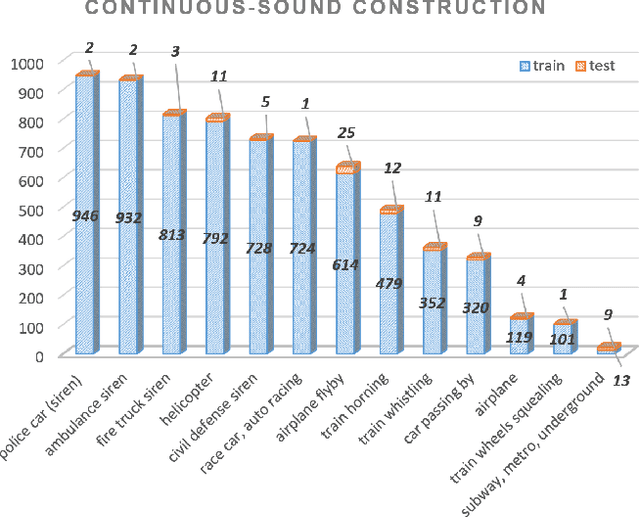
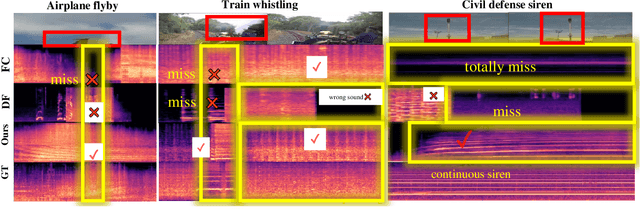
Abstract:The video-to-audio (V2A) generation task has drawn attention in the field of multimedia due to the practicality in producing Foley sound. Semantic and temporal conditions are fed to the generation model to indicate sound events and temporal occurrence. Recent studies on synthesizing immersive and synchronized audio are faced with challenges on videos with moving visual presence. The temporal condition is not accurate enough while low-resolution semantic condition exacerbates the problem. To tackle these challenges, we propose Smooth-Foley, a V2A generative model taking semantic guidance from the textual label across the generation to enhance both semantic and temporal alignment in audio. Two adapters are trained to leverage pre-trained text-to-audio generation models. A frame adapter integrates high-resolution frame-wise video features while a temporal adapter integrates temporal conditions obtained from similarities of visual frames and textual labels. The incorporation of semantic guidance from textual labels achieves precise audio-video alignment. We conduct extensive quantitative and qualitative experiments. Results show that Smooth-Foley performs better than existing models on both continuous sound scenarios and general scenarios. With semantic guidance, the audio generated by Smooth-Foley exhibits higher quality and better adherence to physical laws.
Unified Pathological Speech Analysis with Prompt Tuning
Nov 05, 2024
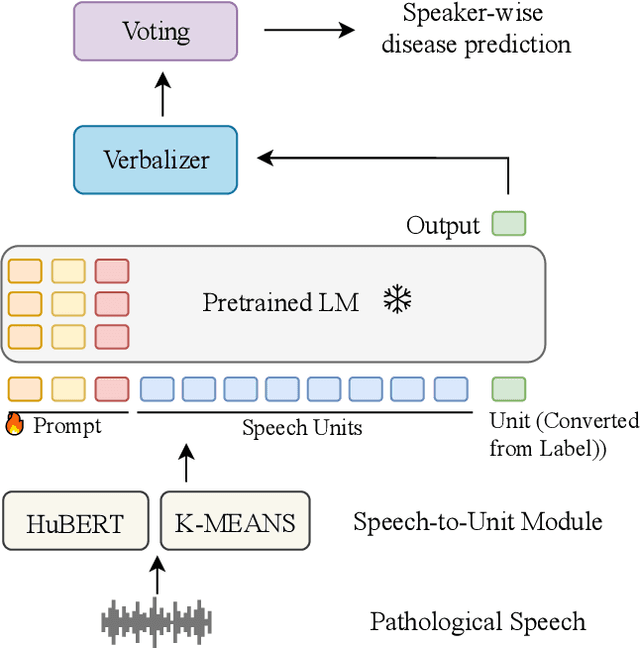
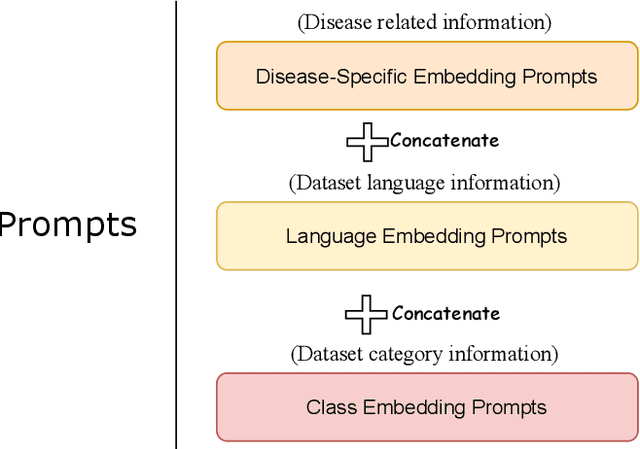
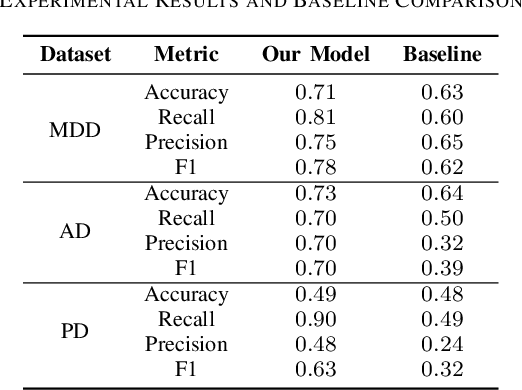
Abstract:Pathological speech analysis has been of interest in the detection of certain diseases like depression and Alzheimer's disease and attracts much interest from researchers. However, previous pathological speech analysis models are commonly designed for a specific disease while overlooking the connection between diseases, which may constrain performance and lower training efficiency. Instead of fine-tuning deep models for different tasks, prompt tuning is a much more efficient training paradigm. We thus propose a unified pathological speech analysis system for as many as three diseases with the prompt tuning technique. This system uses prompt tuning to adjust only a small part of the parameters to detect different diseases from speeches of possible patients. Our system leverages a pre-trained spoken language model and demonstrates strong performance across multiple disorders while only fine-tuning a fraction of the parameters. This efficient training approach leads to faster convergence and improved F1 scores by allowing knowledge to be shared across tasks. Our experiments on Alzheimer's disease, Depression, and Parkinson's disease show competitive results, highlighting the effectiveness of our method in pathological speech analysis.
DRCap: Decoding CLAP Latents with Retrieval-augmented Generation for Zero-shot Audio Captioning
Oct 12, 2024



Abstract:While automated audio captioning (AAC) has made notable progress, traditional fully supervised AAC models still face two critical challenges: the need for expensive audio-text pair data for training and performance degradation when transferring across domains. To overcome these limitations, we present DRCap, a data-efficient and flexible zero-shot audio captioning system that requires text-only data for training and can quickly adapt to new domains without additional fine-tuning. DRCap integrates a contrastive language-audio pre-training (CLAP) model and a large-language model (LLM) as its backbone. During training, the model predicts the ground-truth caption with a fixed text encoder from CLAP, whereas, during inference, the text encoder is replaced with the audio encoder to generate captions for audio clips in a zero-shot manner. To mitigate the modality gap of the CLAP model, we use both the projection strategy from the encoder side and the retrieval-augmented generation strategy from the decoder side. Specifically, audio embeddings are first projected onto a text embedding support to absorb extensive semantic information within the joint multi-modal space of CLAP. At the same time, similar captions retrieved from a datastore are fed as prompts to instruct the LLM, incorporating external knowledge to take full advantage of its strong generative capability. Conditioned on both the projected CLAP embedding and the retrieved similar captions, the model is able to produce a more accurate and semantically rich textual description. By tailoring the text embedding support and the caption datastore to the target domain, DRCap acquires a robust ability to adapt to new domains in a training-free manner. Experimental results demonstrate that DRCap outperforms all other zero-shot models in in-domain scenarios and achieves state-of-the-art performance in cross-domain scenarios.
SLAM-AAC: Enhancing Audio Captioning with Paraphrasing Augmentation and CLAP-Refine through LLMs
Oct 12, 2024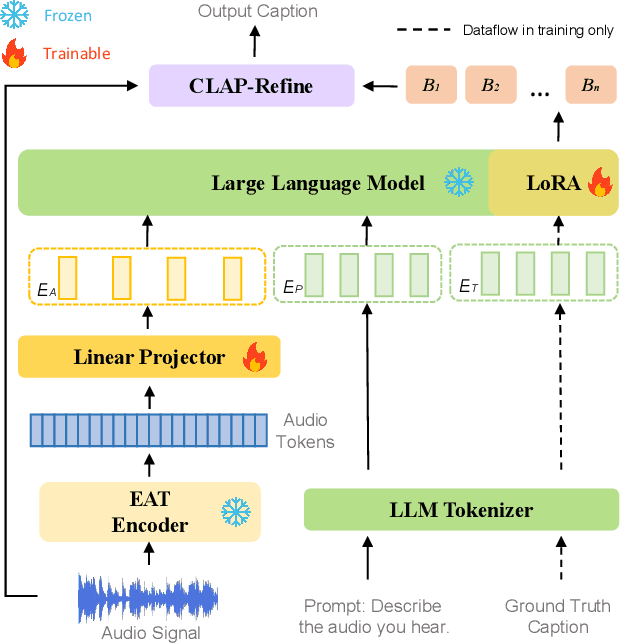



Abstract:Automated Audio Captioning (AAC) aims to generate natural textual descriptions for input audio signals. Recent progress in audio pre-trained models and large language models (LLMs) has significantly enhanced audio understanding and textual reasoning capabilities, making improvements in AAC possible. In this paper, we propose SLAM-AAC to further enhance AAC with paraphrasing augmentation and CLAP-Refine through LLMs. Our approach uses the self-supervised EAT model to extract fine-grained audio representations, which are then aligned with textual embeddings via lightweight linear layers. The caption generation LLM is efficiently fine-tuned using the LoRA adapter. Drawing inspiration from the back-translation method in machine translation, we implement paraphrasing augmentation to expand the Clotho dataset during pre-training. This strategy helps alleviate the limitation of scarce audio-text pairs and generates more diverse captions from a small set of audio clips. During inference, we introduce the plug-and-play CLAP-Refine strategy to fully exploit multiple decoding outputs, akin to the n-best rescoring strategy in speech recognition. Using the CLAP model for audio-text similarity calculation, we could select the textual descriptions generated by multiple searching beams that best match the input audio. Experimental results show that SLAM-AAC achieves state-of-the-art performance on Clotho V2 and AudioCaps, surpassing previous mainstream models.
Efficient Audio Captioning with Encoder-Level Knowledge Distillation
Jul 19, 2024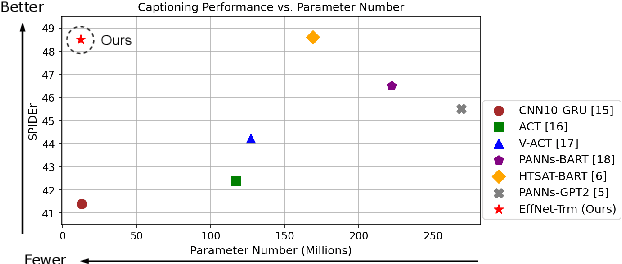


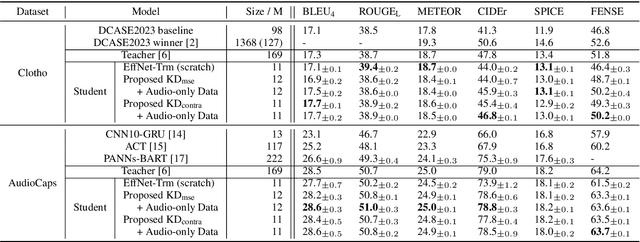
Abstract:Significant improvement has been achieved in automated audio captioning (AAC) with recent models. However, these models have become increasingly large as their performance is enhanced. In this work, we propose a knowledge distillation (KD) framework for AAC. Our analysis shows that in the encoder-decoder based AAC models, it is more effective to distill knowledge into the encoder as compared with the decoder. To this end, we incorporate encoder-level KD loss into training, in addition to the standard supervised loss and sequence-level KD loss. We investigate two encoder-level KD methods, based on mean squared error (MSE) loss and contrastive loss, respectively. Experimental results demonstrate that contrastive KD is more robust than MSE KD, exhibiting superior performance in data-scarce situations. By leveraging audio-only data into training in the KD framework, our student model achieves competitive performance, with an inference speed that is 19 times faster\footnote{An online demo is available at \url{https://huggingface.co/spaces/wsntxxn/efficient_audio_captioning}}.
Enhancing Zero-shot Audio Classification using Sound Attribute Knowledge from Large Language Models
Jul 19, 2024Abstract:Zero-shot audio classification aims to recognize and classify a sound class that the model has never seen during training. This paper presents a novel approach for zero-shot audio classification using automatically generated sound attribute descriptions. We propose a list of sound attributes and leverage large language model's domain knowledge to generate detailed attribute descriptions for each class. In contrast to previous works that primarily relied on class labels or simple descriptions, our method focuses on multi-dimensional innate auditory attributes, capturing different characteristics of sound classes. Additionally, we incorporate a contrastive learning approach to enhance zero-shot learning from textual labels. We validate the effectiveness of our method on VGGSound and AudioSet\footnote{The code is available at \url{https://www.github.com/wsntxxn/AttrEnhZsAc}.}. Our results demonstrate a substantial improvement in zero-shot classification accuracy. Ablation results show robust performance enhancement, regardless of the model architecture.
DiveSound: LLM-Assisted Automatic Taxonomy Construction for Diverse Audio Generation
Jul 18, 2024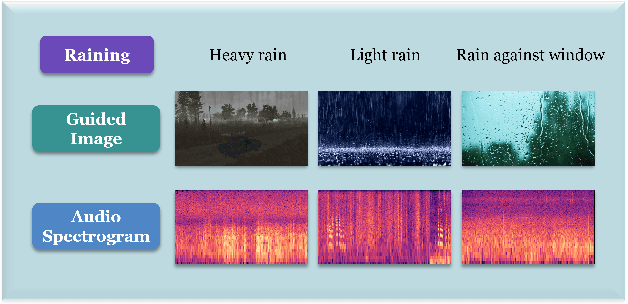

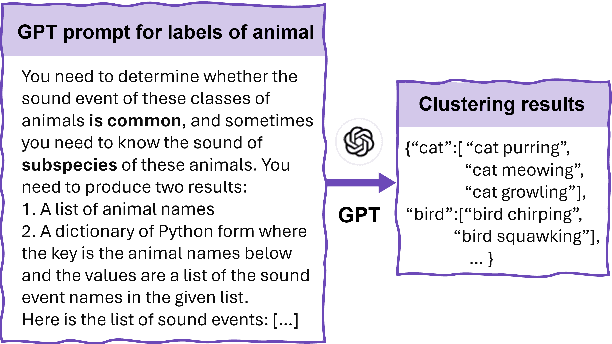
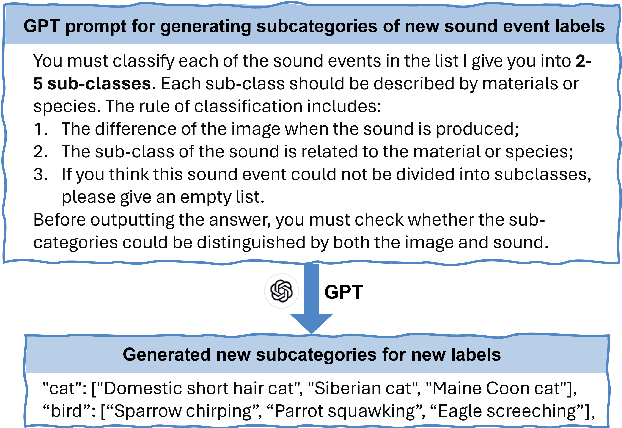
Abstract:Audio generation has attracted significant attention. Despite remarkable enhancement in audio quality, existing models overlook diversity evaluation. This is partially due to the lack of a systematic sound class diversity framework and a matching dataset. To address these issues, we propose DiveSound, a novel framework for constructing multimodal datasets with in-class diversified taxonomy, assisted by large language models. As both textual and visual information can be utilized to guide diverse generation, DiveSound leverages multimodal contrastive representations in data construction. Our framework is highly autonomous and can be easily scaled up. We provide a textaudio-image aligned diversity dataset whose sound event class tags have an average of 2.42 subcategories. Text-to-audio experiments on the constructed dataset show a substantial increase of diversity with the help of the guidance of visual information.
AudioTime: A Temporally-aligned Audio-text Benchmark Dataset
Jul 03, 2024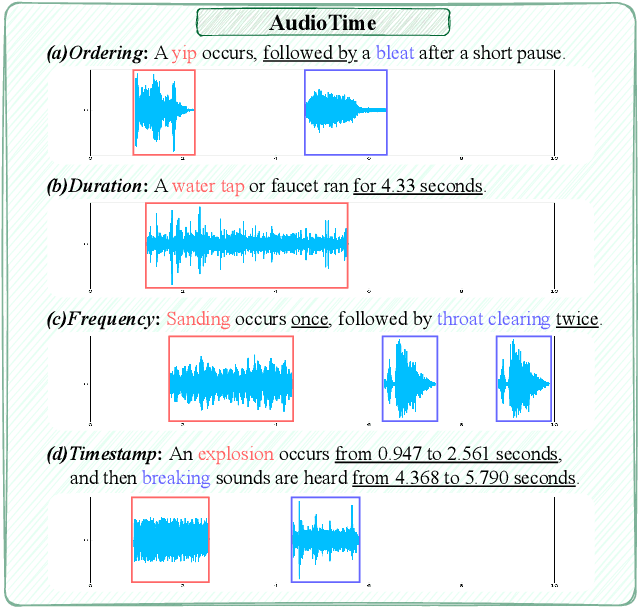
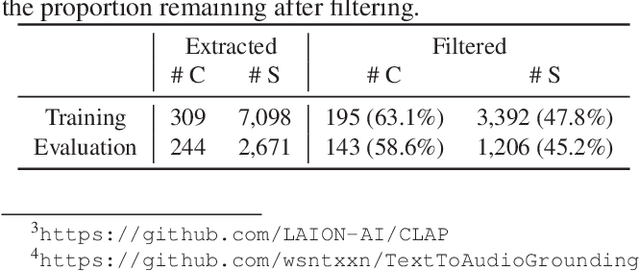
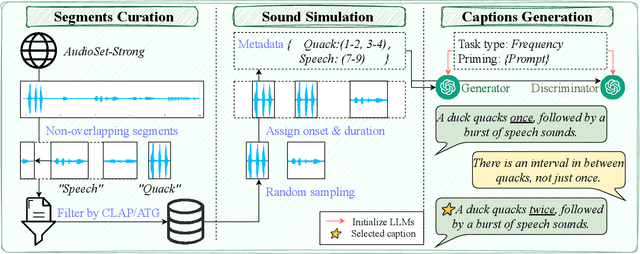

Abstract:Recent advancements in audio generation have enabled the creation of high-fidelity audio clips from free-form textual descriptions. However, temporal relationships, a critical feature for audio content, are currently underrepresented in mainstream models, resulting in an imprecise temporal controllability. Specifically, users cannot accurately control the timestamps of sound events using free-form text. We acknowledge that a significant factor is the absence of high-quality, temporally-aligned audio-text datasets, which are essential for training models with temporal control. The more temporally-aligned the annotations, the better the models can understand the precise relationship between audio outputs and temporal textual prompts. Therefore, we present a strongly aligned audio-text dataset, AudioTime. It provides text annotations rich in temporal information such as timestamps, duration, frequency, and ordering, covering almost all aspects of temporal control. Additionally, we offer a comprehensive test set and evaluation metric to assess the temporal control performance of various models. Examples are available on the https://zeyuxie29.github.io/AudioTime/
PicoAudio: Enabling Precise Timestamp and Frequency Controllability of Audio Events in Text-to-audio Generation
Jul 03, 2024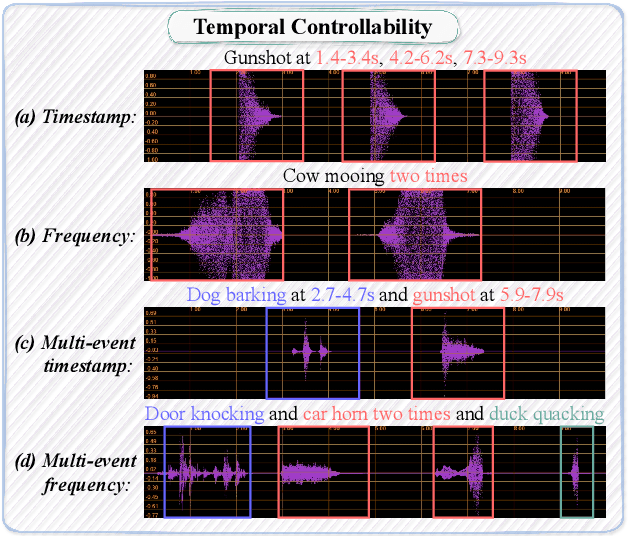

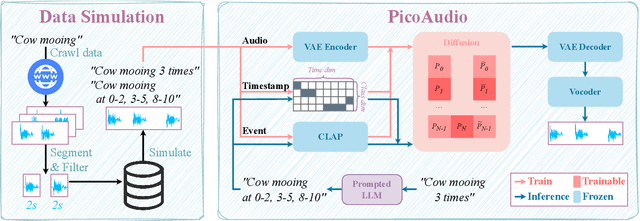
Abstract:Recently, audio generation tasks have attracted considerable research interests. Precise temporal controllability is essential to integrate audio generation with real applications. In this work, we propose a temporal controlled audio generation framework, PicoAudio. PicoAudio integrates temporal information to guide audio generation through tailored model design. It leverages data crawling, segmentation, filtering, and simulation of fine-grained temporally-aligned audio-text data. Both subjective and objective evaluations demonstrate that PicoAudio dramantically surpasses current state-of-the-art generation models in terms of timestamp and occurrence frequency controllability. The generated samples are available on the demo website https://PicoAudio.github.io.
 Add to Chrome
Add to Chrome Add to Firefox
Add to Firefox Add to Edge
Add to Edge